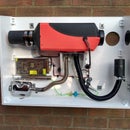Introduction: Repairing a Samsung Galaxy S3 Earphone Which Crackles or Cuts Out
Close inspection showed that it was likely to be a broken wire inside the white cable, probably just by the microphone (the white cable looked thin and weak at this point - it had probably been bent to-and-fro too much).
This instructable shows some pictures of the steps needed to repair it.
Don't bother trying, unless you have:
- a fine soldering iron
- a sharp knife
- a strong magnifying glass
- a very fine pair of tweezers
- a steady hand.
Step 1: Find the Problem
Identify a possible problem area. Look for a damaged cable. I was suspicious of both ends of the microphone.
Step 2: Open Up the Microphone
The microphone is NOT a 'snap-shut, snap-open' affair. It seemed to be glued lightly together.
I took a very sharp knife and gently worked my way along the seam, going part-way through at first, then going back along. Eventually, the corners started to part and some leverage began to open up the plastic case.
The side with the buttons, came off first, leaving the tiny printed circuit board (PCB) wedged (glued?) into the other half of the case.
Sliding the knife-point under the PCB made it pop out.
Step 3: Cut and Prepare the Wires for Re-soldering
This is the hardest step.
I cut the faulty wire off to avoid pulling on the PCB pads.
Then I fiddled and pulled to get the strain-relief bush down the cable a bit - it needs to be on the cable when the job is done! I actually pulled it off first to free it from the cable sheath. Then I fed it through and pulled it down. I EASED the strain-relief bush along the cable - I did not want to break the fine inner wires during this process!
Then I started to strip off the white covering to reveal the inner wires.
In order to tie a knot in the wire (as the manufacturer did), you need about 1.5" of stripped cable - this means you are going to shorten the cable by about this much. If that were not acceptable, perhaps a blob of glue (epoxy, glue-gun, or rubber cement?) might secure the inner wires enough?
Eventually, I had a tight knot and had shortened the conductors to 5mm - 7mm in length ready for soldering.
Step 4: Solder and Close-up
I have a very fine-tipped soldering iron, with temperature control.
I had no problems removing the old wires/knot.
I carefully tinned the prepared wires - had a big shock as the plastic cores of the two wires melted away. I think I had the temperature of the iron set a bit high (400 deg C). I would suggest using flux and applying the soldering iron for as short a time as possible - just enough to tin the cables.
The soldering was very fine and needed a very steady hand. If the case is to be closed at the end, you have to have very short wires!
Finally, the case was re-assembled with very little effort.
Use a pin to feed a bit of super-glue or similar to the joint between the white cable-sheath and the strain-relief bush (to stop the white cable pulling out of the bush).
Similarly, apply a bit of glue to hold the microphone casing together.
Happy listening.













